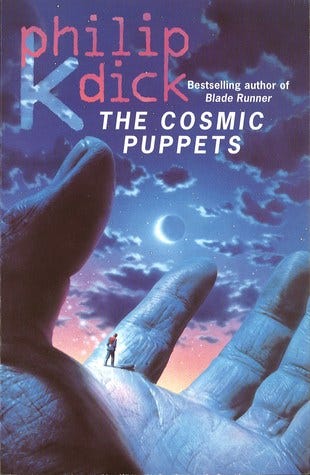Book Reviews: THE COSMIC PUPPETS and EYE IN THE SKY by Philip K. Dick
1950s PKD was weird ahead of his time
1.
Book Review: THE COSMIC PUPPETS (1957) by Philip K. Dick.
This is one of Dick's lesser-known early novels — so short it's almost a novella — and full of the weirdness that became his hallmark.
The protagonist visits his childhood small town Millgate. He expects a pleasant nostalgia trip. Instead he finds an alternate-reality version of the town — a version where he no longer should exist.
Millgate has split in two. There is the town he remembers, and also the different, decaying version that seems to have replaced it. Eventually it becomes evident that the small town has become the battleground of two ancient, competing forces — one good, the other one evil...
Parts of this novel are reminiscent of Stephen King (if King had known how to write with fewer words) — an American small town haunted by a supernatural evil, kids with magical powers. But it's unmistakably a Philip K. Dick story.
I wish more novels were as brief as this one! Perhaps the ending is a bit weak, and the story is a tad too simplistic, but the novel as a whole works and would make a pretty good Urban Fantasy movie.
THE COSMIC PUPPETS is recommended for its entertainment value.
2.
Book Review: EYE IN THE SKY by Philip K. Dick (1957)
I count this as one of Philip K. Dick’s best novels, and one of his funniest. It has a satirical streak, though it also covers familiar PKD themes: multiple realities, schizophrenia and paranoia. (What’s “missing” from EYE IN THE SKY is the theme of drugs, which he would return to again and again.)
From a technical standpoint, this novel is one of his most well-written and neatly structured — more so than his later novels. It’s also less dark than his other best works.
The science fiction device that sets the plot in motion is pure 1950s pulp: Accidental exposure to radiation throws the characters into an alternate reality. (It’s almost on the level of “Peter Parker gets bitten by a radioactive spider...”)
But EYE IN THE SKY is really about something else: What if every person lives in their own reality “bubble”? And what would it be like to enter someone else’s personal “bubble”? To live inside another person’s delusions?
Another way of phrasing this theme is, to put it bluntly: What if every person is secretly crazy? And that is the real theme of the novel: We’re all mad, to a lesser or greater degree, in our own private way, and that is a human comedy.
So what makes EYE IN THE SKY a funny book? Three reasons:
The characters in the story get to visit the personal “realities” of the other characters. And apart from one such “reality” (which is truly scary), these alternate worlds are ridiculously focused on some personal obsession: Fanaticism, or excessive prissiness, or plain single-mindedness. Whatever seems very important and serious to one person’s own sense of reality, seems ludicrous to everyone else.
The most comical scenes in the book depict the “logical” consequences of the characters’ personal obsessions — and they are laugh-out loud hilarious. Such as when… no, I mustn’t spoil the fun.
The second reason why EYE IN THE SKY is comedy, is that this all takes place in 1950s America, just before the advent of the hippie era.
Ten years later, Philip P. Dick would write about similarly weird characters and fracturing realities… but by then, his weirdness was much less of a contrast to the surrounding culture.
You could say that it took some time for America to catch up with Dick. (A protagonist who hallucinated an alternate reality in 1967 could be a hippie, or even a celebrity. In 1957, that person would be committed.)
The third reason why EYE IN THE SKY is a comedy, is that it actually has a happy ending. (Well, “happy” for a PKD story.)
I recommend EYE IN THE SKY as a “lighthearted” (sort of) and very entertaining PKD novel. Even though it takes place in 1950s America, the way it pokes fun at human behavior is timeless.




